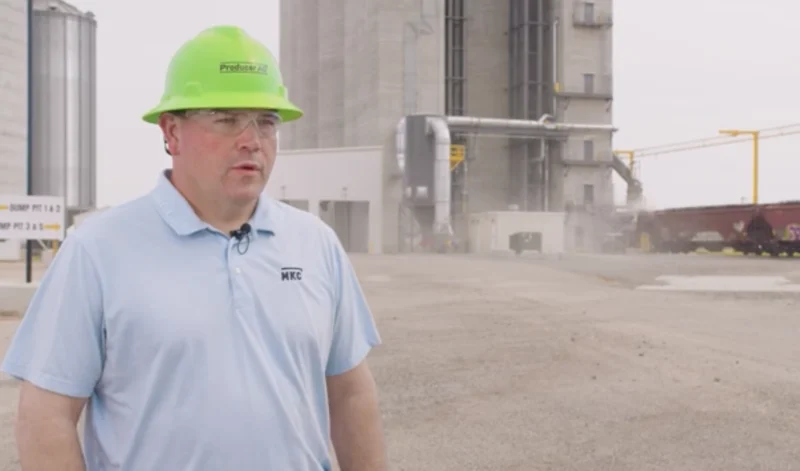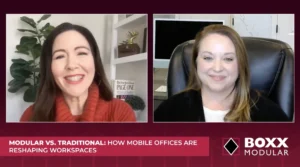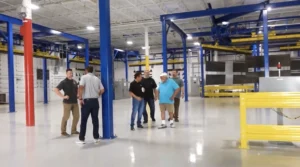Don’t Be Afraid of Paint Automation
All it takes to start a spirited discussion in manufacturing is to bring up the topic of robotics and automation. It’s a fascinating subject that has been glorified through industry trade publications for decades. The only problem? Most of the systems are geared toward the high-production sectors of Tier 1 and automotive manufacturers that have implemented robotics in every phase of their process. There have been some progressive manufacturers in general industry that have successfully adapted robotics to their high-mix/low-volume applications for welding, part handling, and machine tending.
But many other robotic systems have been harder to implement. Finding information on welding and pick-and-place robotic technology is as easy as picking up a trade publication, as long as the same parts are made repeatedly. But one area that has largely been untouched in general industry is finishing.
As the technology and automation systems for fabrication equipment and welding have dramatically increased the production capabilities of manufacturers, it seems that the available technology runs out at the last step in the manufacturing process—finishing. Most companies still rely on the manual labor of a few key finishers to prep and coat parts in finishing systems even as production and quality expectations continue to increase. This often results in parts sitting in queue, waiting to be finished before shipping. Companies are also struggling to find enough painters to offset these increased production capabilities. Maybe that’s because painting and finishing are largely thought of as dirty, dangerous, and repetitive. The next generation is not choosing finishing careers as the industry’s experts are retiring. All this adds up to a real problem for manufacturers.
So why then hasn’t robotic technology taken root in finishing? Because most companies don’t know where to start.
First, finishing areas are considered hazardous environments. Paints and powders create an explosive environment classified as a Class I, Division 1 area where electrical components need to be protected to operate safely. Second, spraying paints and powders have constantly changing variables exacerbated by high-mix/low-volume production requirements. This renders typical programming methods unsustainable. And third, it’s difficult to add new elements like robotics to existing legacy equipment that is large, expensive, and already integrated for all stages of the finishing process.
Where to Start
All this may sound overwhelming, but it doesn’t have to be. This is a problem that North American manufacturers must solve together to stay competitive in the global economy. Blame it on regulations, limited equipment options, or cheap overseas labor; North America’s automated finishing capabilities for general industry are behind. In an effort to add clarity to the situation, here are the primary things any fabricator needs to consider when exploring robotic options for their shop. As one can see, it goes beyond just selecting a robot.
1. Is the Robot NRTL Class l, Division 1-Certified?
Safety regulations in Canada and the U.S. continue to expand, and electrical and OSHA inspectors are beginning to take a closer look at all industrial equipment to make sure it’s approved by a Nationally Recognized Testing Laboratory such as UL, ETL, or FM. The added safety requirements for an NRTL Class I, Division 1 environment require a completely different robot design, and some industrial robot companies don’t even make a robot line for painting.
For the most part, non-North American finishing robot manufacturers work under ATEX certification. However, in order to enter North America, robots must be certified by an NRTL as Class I, Division 1. While these standards are necessary to ensure quality and safety, it’s challenging for newer players in robotics manufacturing to meet the different requirements of each certification.
2. Has the Application Been Considered?
In finishing, robots are not one size—or type—fits all. There are many factors concerning part presentation, throughput, reach, and paint quality that determine the proper robotic finishing system to meet every fabricator’s unique requirements. A robot is only as good as the person teaching it. A robot programmer who doesn’t know the nuances and sequences needed to achieve the desired finishing quality of their company’s parts may fail at properly programming a painting robot. Here are the three main types of robots that can be used in the finishing industry:
- Industrial robots are fast, accurate, and can carry a high payload. They can be used for welding, packaging, material handling, machine tending, quality inspections, Tier 1 and automotive finishing, and more.
- Collaborative robots are very precise and quick to deploy because they don’t need safety protection around them. But they have a low payload and move much slower than industrial robots. They are programmed by manually moving the robot to set points. The path and command sequences are set to create a program. These robots are ideal for CNC machine tending, assembly, material handling, and quality inspections.
- Self-learning painting and finishing robots, which are new to North America, allow a finisher to generate a program very quickly. The robot has the ability to disengage all of its motors and go into a weightless free-float learning mode. The finisher then takes control of the weightless robot and spray gun and finishes the part. The robot creates a program from the manual sequence in real time and replicates the sequence using intricate human-like movements. They have a lighter payload, which is perfect for non-contact applications such as spraying, blowing, and vacuuming.
3. What About Software?
To perform a repeatable series of motions, the robot relies on lines of code stored in a file or program. To create this file, programmers have several software methodologies to consider:
Offline programming uses software to create a path and simulate in a 3D world. This type of programming is common in many applications, including painting. Using this type of programming does not stop production while the programmer creates the program. Industrial, collaborative, and self-learning robots can be programmed offline.
Teach pendant programming uses a hand-held pendant or touchpad to create a series of commands and point-to-point positions or paths at the robotic station. It requires production to stop while changes are made. Teach pendants are also used to adjust positions and commands already programmed either manually or from offline. Some teach pendants are very intuitive, while some are limited. Both require a significant amount of time to create programs. Teach pendants are used to program and move industrial and collaborative robots.
Self-learning programming is done by painters rather than engineers or robotic programmers. It takes into consideration the importance of the human eye and intuition that comes from years of experience to avoid missed spots and overcome the Faraday cage effect. It involves disengaging all robotic motors to enter into a weightless free-float learning mode. The painter attaches a control handle, which controls the automatic powder, liquid, and blowoff/suction gun. The robot records all of the painter’s movements, right down to the subtle variances in gun angle, part coating sequence, and trigger pulls. In other words, all the knowledge and experience of the operator are transferred into the robot program in real time so the robot performs the same human-like movements. From a personnel point of view, this system is able to replicate all the time and investment a fabricator has put into his or her employees. This type of programming can be used only by self-learning painting and finishing robots.
3D scanning/automatic program generation involves a 3D scan of the part and uses software to generate a painting path. This programming method can be used on simple parts without complicated geometries. 3D scanning can be used in all categories of robots (industrial, collaborative, and self-learning).
4. What About Programming Time?
The programming time for different robots can vary significantly. Finding a robot that meets a fabricator’s production needs and programming capabilities is key to successful integration in a paint or powder system.
In Tier 1 and automotive facilities, it can be quite easy to justify the cost of programming part families because volume is high enough to warrant the time to program. This has allowed these manufacturers to build large robotic painting systems. These systems can be ideally suited for industrial robots because they use higher-payload application equipment that can operate at high speeds. Even though these systems require extensive programming times, once running, they have the capability of high output with high quality.
However, in the high-mix/low-volume world of general industry manufacturers, there can be hundreds of different parts running through the shop at a given time. This can cause programming to become an extremely daunting and cost-prohibitive task. Self-learning paint and finishing robots are suited for this scenario because programs can be made very quickly. It’s as simple as using the robot to paint the first part in production. Once the painter has completed teaching the robot how the part is supposed to be finished, the robot is free to replicate it. In certain situations, the painter can even teach these programs in the production line without stopping the conveyor or production.
5. How Will the System Work Together?
A successful automated finishing system needs four key groups to work together: the fabricator, an automation integrator, a finishing system equipment distributor, and a paint/powder distributor.
Each party must know its roles and support each other—much like the legs of a chair—to work successfully. If any one of the four does not support the system, the chair (and system) will fall. Fabricators should look for a robotic finishing system integrator that has experience with the equipment companies they already have relationships with. This creates an easier transition to automation for the team.
6. What About System Design and Investment?
A robotic finishing system has many important variables that can affect overall system performance. Powder and liquid applications are affected by part presentation, environmental conditions, equipment selections, and paint/powder changes. These variables need to be discussed by the four key system groups mentioned in the previous point and work together to decide which need to be addressed for each application’s requirements.
A perfectly programmed robot will repeat the same saved program every time, but the results can be affected by many things, including:
- Part presentation.
- Varying ambient air temperature and humidity.
- Booth design and airflow.
- Electrostatic grounding of part.
- Injector nozzle/tip clogs.
- Varying compressed air temperature and humidity.
- Powder quality.
- Paint mix ratio.
- Paint viscosity.
In a manual application there are also variables that are addressed and compensated for throughout the application at the gun by the manual painter: flow, electrostatic, speed and distance from the part, atomizing air, and fan pattern.
With a robot, it’s ideal that all of these potential variables are addressed in advance. The more of these variables that are controlled, the more repeatable the application will be. The more variables that remain in the system, the more vigilant and adaptable the system operators and programmers need to become.
Done Right, Robotics Is an Investment That Pays Dividends
When it comes to robotics, many configurations and accessories are available to make a fabricator’s life easier. However, it’s always good to go into such a decision knowing what questions to ask to help make the right choice.
Using automation for finishing involves more than selecting a robot. Operators need to be able to adapt programs and application equipment to be successful using robotics. Discussing options with automation integrators is a good first step as they are the ones to help bring everything together seamlessly.
Paint and finishing robots can be a valuable asset to shops of every size as they create a safer working environment, provide consistent finish quality, and reduce bottlenecks and downtime. Remember, a robot is not a silver bullet. It should be easy to program, adaptable, and empower the team. This creates an engaged workforce with the tools to be in control of the quality they produce. Painting and finishing robots can become an extension of a fabricator’s team and multiply their efforts for the company to accomplish more.
Derek DeGeest is president of DeGeest Steel Works and LestaUSA Self-Learning Painting and Finishing Robots, 27191 470th Ave., Tea, S.D. 57064, 888-546-2800, www.lestausa.com.









